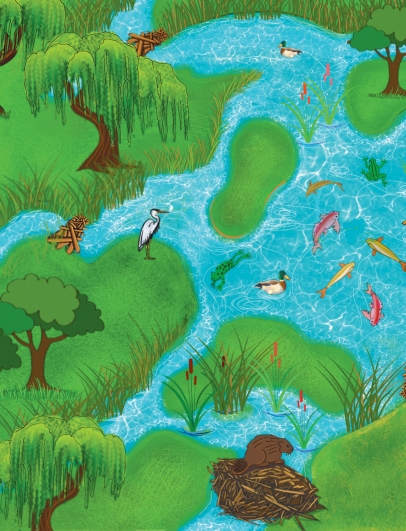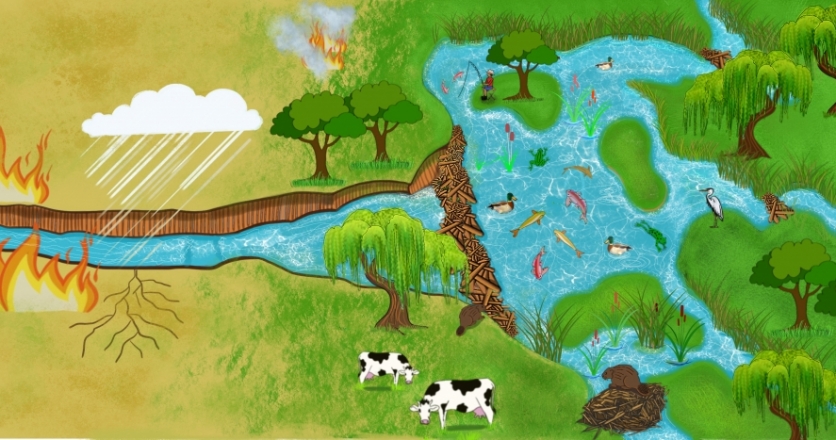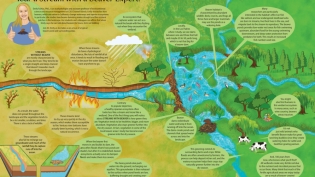Dammed If They Don’t
Could a creature left out of Southern California history revive its waterways?
This piece was supported by a Society of Environmental Journalists funding award, underwritten by The Hewlett Foundation, The Wilderness Society, The Pew Charitable Trusts and others.
Parts of Ventura County’s Sespe Creek are nearly as wild today as they were in the early 1900s, when Joseph Grinnell first caught wind of the “unexpected find” there. It’s hard not to wonder what might still lay hidden among its rugged terrain.
If you know what to look for, you can still make unexpected finds of your own: old chewed up sticks or, via satellite, structures bearing the characteristic signature of the creatures’ engineering feats.
Where did the beaver come from, are they still here, and do they belong here? “It’s like a Sherlock Holmes mystery,” said Rick Bisaccia, Ojai Valley Land Conservancy’s former stewardship director, of the 100-year-old hunt for answers. And the answers could point the way out of many of Southern California’s ecological quandaries.
“Trying to mitigate floods or improve water quality?” writes Ben Goldfarb in his book Eager: The Surprising, Secret Life of Beavers and Why They Matter (Chelsea Green Publishing, 2018). “There’s a beaver for that. Hoping to capture more water for agriculture in the face of climate change? Add a beaver. Concerned about sedimentation, salmon populations, wildfire? Take two families of beaver and check back in a year.”
As “ecosystem engineers” second only to humans, beavers build dams, ponds and channels that capture and redistribute water across and into the landscape. This redistribution invigorates habitats, recharges groundwater and performs a variety of vital ecosystem services that would, in human hands, cost a fortune. “Ecological and hydrological Swiss Army knives,” Goldfarb calls them.
But are they tools fit for Southern California? Put another way, are they native?
THE HISTORY VS. THE HUNCH
In 1937, Joseph Grinnell, the first director of the Museum of Vertebrate Zoology at Berkeley, answered that question in a hefty treatise on California’s fur-bearing mammals: no. Or rather: no, but…. On his California beaver range map stood a lone question mark far south and west of any other native population. Grinnell was apparently unconvinced of what had been found there. The mark was right atop Sespe Creek.
Fifty years later, Rick Lanman looked behind his Bay Area home and wondered why a stream that used to flow year-round until the 1950s was now dry half the year.
“One of my theories was maybe beaver perennialized it,” said Lanman, who is a physician, researcher, self-proclaimed serial biotech entrepreneur and founder of The Institute for Historical Ecology. Beavers’ heavy ponds push water into the ground during wet times. Then, in dry times, the replenished groundwater feeds the stream.
But according to the ghost of Grinnell, who continued to haunt official beaver range maps, the Bay Area was also a beaver desert. “Which doesn’t make any sense,” Lanman said. The animal thrives in both the Canadian tundra and the deserts of northern Mexico. Why not coastal California? Lanman and his colleagues went digging for answers.
But like the creatures themselves, the human-beaver historical record is, well, eccentric.
Sometime after 1923, the California Department of Fish and Game and the US Forest Service began sprinkling beavers all over the state. On one occasion, literally: in boxes by parachute. Even back then, and despite not thinking them native, the land managers understood that a well-placed beaver could do wonders for the environment.
Ventura County got its beaver delivery as well: at least 36 total between 1942 and 1949, including six in the Sespe.
HEADS AND TALES
Any evidential beaver specimens therefore had to predate the great beaver sprinkling of 1923 in order to show the creature was native. However, any beaver specimens that predated 1906 could have gone up in smoke with the devastating San Francisco fires, along with the rest of the California Academy of Sciences.
Luckily, history is written all around us and in 2013 Lanman and his co-authors published their results. All over California, they found beaver evidence in old newspapers, ships’ logs, fur trapper journals and place names. Local Chumash references included words for beaver, a beaver dance, a shaman’s beaver-skin rainmaking kit and perhaps even a beaver pictograph. It appeared the once-widespread creature had been hunted—in some places to near extinction—by the time Grinnell examined their range.
These were clues, but in science direct physical evidence outweighs words. A skull specimen and carbon-dated dam remains settled the case in the Bay Area and the Sierras respectively. What about Southern California?
What Grinnell had symbolized on the map with his Sespe question mark was, in life, the origin of a beaver skull specimen. And when Lanman uncovered letters between Grinnell and the skull’s collector, zoologist John Hornung, the Sespe question finally got its answer:
On May 19, 1906, Hornung chanced upon the dying beaver near Hartman Cold Springs Ranch in the Sespe. An “unexpected find,” he called it. Perhaps, though not too unexpected. “There are still quite a few beaver in Southern California,” he added.
“What Grinnell… had failed to account for,” wrote Goldfarb, “was history.”
BEAVERS TODAY?
Today, mounting evidence may have settled the matter of whether or not beavers belong here. But whether they are still here is a whole other story.
The last report I could find of anyone who had actually seen a beaver in Ventura County (or, more accurately, someone who had heard of someone who had seen them) was in the 1990s.
“The original Sespe population, if it’s still there, is quite small,” said Emily Fairfax, PhD, an assistant professor of environmental science and resource management at California State University Channel Islands. “And it’s staying pretty far away from people.”
But that’s only part of the story. Up in the Los Padres National Forest of neighboring Santa Barbara County, where Fairfax and her team study beavers, there are hundreds of beaver dams coming off Lake Cachuma alone. And Fairfax has noticed that they are working their way toward Ventura County.
“They’re definitely coming,” she said, noting beavers in every surrounding county. Likely, they’re already here.
CAN HUMANS MAKE ROOM FOR BEAVERS?
California beaver work remains complicated by its history. For example, policy remnants prohibit beaver relocation, says Fairfax. And, according to 2016 WATER Institute report, Beaver in California, no CDFW codes promote beaver stewardship or restoration.
Public perception can also complicate the matter. Though Fairfax’s work details how beaver activity can act as a fire break and drought buffer, beavers have their own agenda.
“Beavers are absolutely an agent for good in the environment, but…sometimes they will conflict with humans,” she says. A dam-induced flood enriches soil and improves water quality and availability in the future, but it’s hard to stomach a flooded farm crop to get there.
Luckily, beaver experts are also innovators. Inventions such as “beaver deceivers” give humans influence over pond levels or dam locations and simple trunk treatments can discourage the gnawing of a prized tree. Beavers and humans won’t be able to coexist in every situation, Fairfax cautions, but she encourages “taking that extra minute to stop and think: If there is a beaver, how can I interact with it in the neutral way, instead of trying to control it?
And perhaps, in the end, relinquishing a bit of control is the moral of the California beaver story. In an increasingly dynamic climate, we humans still think and build statically, encasing our rivers in concrete. Beavers, however, build for flux, for generations and for an interspecies community.
“The beaver is the story of someone who is working hard and they’re trying to make the environment a better place… for their families and for the future,” says Fairfax.
Yes, beavers belong here because they benefit us and other creatures. But mostly, one might point out, they belong here because they always have.








